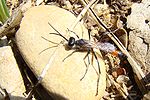Thread-waisted wasp
| Thread-waisted wasp |
|---|

|
| Scientific Classification |
|
| Subfamilies and Genera |
|
Subfamily: Ammophilinae
Subfamily: Chloriontinae
Subfamily: Sceliphrinae
Subfamily: Sphecinae
|
Thread waisted wasps are any of the species of wasps that belong to the taxonomic family Sphecidae. They possess many of the characteristics typical of other wasps except its thorax is very thin (like a thread) leading to its name - a thread waisted wasp.
Anatomy
The reason why the thread-waisted wasp has its name is because of its thin waist, which makes the wasp different from the rest. The size of the wasp is 16mm to 55mm (0.63in to 2.17in) which is about the size of four quarters and the females sting paralyzes insects to then eat and bring underground to the ditch the female made earlier for her larva [1].The wasp typically is a solitary bug. It's also colored as blue or black glossy feature [2]. The times to see the thread waisted wasp is usually in July, August and through September in the warmer tempters [3].
Reproduction
The mating ritual made by the male and female thread wasp is a mating of sexual reproduction usually done in the summer. They do this by first finding each other, then the male grasps onto the female and is placed a little behind the females head and grasps firmly. Meanwhile, the female remains her normal business gathering nectar, and later grabs the insect of choice by the female, and lays her eggs onto the bug in the hole prepared for the larva to then later eat and grow to be adults[4].The anatomy changes as well as the some of the shape of the species and geniuses that you go to, and the others are differently colored, and are a little different in size, but still have the same trait the thread waist which makes them different from all other bees and wasps alike.
Ecology
Typically the thread waisted wasp lives in the flowery food crop areas [5]. In the Northwest, there are many places 38 of 50 states such as Maine, New Hampshire, Vermont, New York, New Jersey, Maryland, Massachusetts, Rhode Island, Connecticut, Delaware, Pennsylvania, West Virginia, Virginia, North Carolina, South Carolina, Georgia, Kentucky, Tennessee, Ohio, Michigan, Illinois, Missouri, Arkansas, Mississippi, Louisiana, Alabama, Texas, Oklahoma, Kansas, Colorado, Arizona, Utah, New Mexico, Nevada, California, Oregon, Washington, and Montana [6]. The thread waisted wasp also has food preferences such as crickets, cicadas, spiders, flies and leafhoppers for their larva, and the adults like flowers, nectar and pollen of plants. Their favorite is the black widow. For the typical thread waisted wasp, the cicada wasp likes the cicada [7].The habitats made by the thread waisted wasp are built under ground, and others consist of mainly mud, and are made in high places and stay in places where there is very little vegetation because they don’t rely on only nectar they can feed on other substances. Other homes made by other species of the thread waisted wasp are some burrowed into plant stems, and inhabit the abandoned homes of bee’s in logs[8].
Interesting Information
The thread waisted wasp, when it gathers its larva food, paralyzes the legs, then carries it to the mud nest where it then lays its eggs on it, and the larva hatch and begin to first eat the legs so that the spider stays alive longer so it is preserved longer, and then they eat the body after that. Another interesting fact is if you see a mud cave made by the thread waisted wasp,you can destroy it because it's been there for awhile [9].
Gallery
References
- Taxonomy author unknown, Iowa State University Entomology, 2003-2010.
- Anatomy/Ecology Insect Identification, Runaway Studios, 2005-2011.
- Ecology/Anatomy Howard Garrett, Dirt Doctor, 2010.




